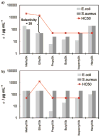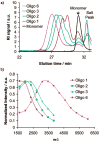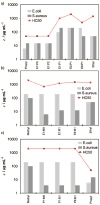Antimicrobial polymers prepared by ROMP with unprecedented selectivity: a molecular construction kit approach
- PMID: 18593128
- PMCID: PMC4106262
- DOI: 10.1021/ja801662y
Antimicrobial polymers prepared by ROMP with unprecedented selectivity: a molecular construction kit approach
Abstract
Synthetic Mimics of Antimicrobial Peptides (SMAMPs) imitate natural host-defense peptides, a vital component of the body's immune system. This work presents a molecular construction kit that allows the easy and versatile synthesis of a broad variety of facially amphiphilic oxanorbornene-derived monomers. Their ring-opening metathesis polymerization (ROMP) and deprotection provide several series of SMAMPs. Using amphiphilicity, monomer feed ratio, and molecular weight as parameters, polymers with 533 times higher selectivitiy (selecitviy = hemolytic concentration/minimum inhibitory concentration) for bacteria over mammalian cells were discovered. Some of these polymers were 50 times more selective for Gram-positive over Gram-negative bacteria while other polymers surprisingly showed the opposite preference. This kind of "double selectivity" (bacteria over mammalian and one bacterial type over another) is unprecedented in other polymer systems and is attributed to the monomer's facial amphiphilicity.
Figures







References
Publication types
MeSH terms
Substances
Grants and funding
LinkOut - more resources
Full Text Sources
Other Literature Sources

